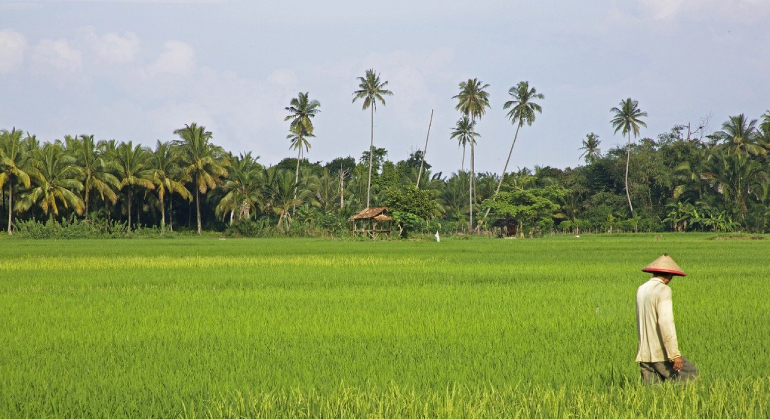
Examining global warming and rice yield productivity with Professor Dr Apichart Vanavichit, Director of the Rice Science Center
Rice (Oryza sativa L.) is a major crop, providing food for billions of people globally. However, rice yield and cultivation is less water productive, requiring approximately 2,500 litres of water per kilogram of polished grain produced (Bouman, 2009).
Irrigated rice consumes about 34%-43% of the total water used for irrigation globally, partly to maintain productivity and control weeds. In Thailand, the irrigation system covers only 22% of agricultural land, whereas the large lowland rain-fed area depends on annual rainfall. If Thailand’s maximum temperature is increased by 1%, half of the rice yield may risk crop loss.
By 2050, the rainfed lowland rice will be shrinking by half if there is no significant improvement in heat and drought tolerance. A million-dollar question is whether rice can become more water-saving and remains productive under restricted irrigation system and global warming.
Stomatal phyllosphere and productivity
All plant leaves and floral parts contain several thousands of microscopic porous organs called stomata. The organs are distributed all over the phyllosphere, including the surfaces of leaves, leaf sheaths (stem), floral parts and even on tiny anthers.
Functioning as a gatekeeper, stomata regulate the opening and closing of their guard cells in response to light, moisture, CO2 and temperature to control transpiration and gaseous exchange.
By increasing stomatal aperture, on the one hand, plants enrich CO2 for photosynthesis while losing moisture and cooling down as a result. On the other hand, stomata closure reduces CO2 uptake and evaporation to save water content under drought conditions but increases canopy temperature.
In addition, some rice pathogens utilise stomata to get inside the leaf to initiate infection. Throughout the entire plant growth cycle, stomatal development is resilient to changing light, CO2, temperature and moisture conditions, which certainly affects crop productivity and water use efficiency (WUE), the term determined by amount of biomass produced per water used.
The fact that rice has one of the densest and smallest stomata of all plant species helps explain why rice is among the lowest WUE and susceptible to combined drought and heat.
Transgenic approaches to improve WUE
Can rice become more efficient in water use under heat and drought stresses simply by genetic alterations of stomatal density and size?
Currently, there are transgenic and non-transgenic approaches. Two transgenic approaches to reduce stomatal density in rice by overexpressed EPF1, a negative regulator, and a knock-out EPFL9, a positive regulator, using the Crisper-Cas9/CpF1 successfully reduced stomatal density in IR64 and saving up to 40% of water use during the vegetative growth. (Yin et al 2017; Caine et al., 2018).
Despite the promising potential of CRISPR for future plant breeding in Argentina, Brazil, Chile, Colombia, China, Japan and Australia, the technique has not yet been fully approved in many countries, including Thailand.
Non-transgenic approaches to improve WUE
In a non-transgenic approach, we utilised well-developed fast-neutron mutagenesis to induce distinctive stomatal density and size in purple rice. Such mutants were characterised microscopically and tested for physiological responses to light, CO2, heat and water stresses. In particular, the low-density mutant (LD) expressed a 40% reduction in stomatal density from its high-density counterpart (HD) (Pitaloka et al., 2022).
Although the degree of reduction is moderate compared with the transgenic IR64 rice, the LD was more resilient to the impacts of increasing CO2, heat and water stresses by maintaining less reduction in photosynthetic capacity, leaf drying, grain yield but gained better harvest index, WUE and biomass/plant in the long-term water-stress treatment in the field than its high-density counterpart.
Moreover, all successful mutants selected under severe drought conditions were low stomatal density. The microscopic selection could be treated as a functional biomarker to replace field screening in breeding for WUE.
Another challenge remains to be solved. Can productivity be improved further for low stomatal density rice cultivated in a high input production? We successfully developed low stomatal density rice that yielded more than six ton/hectare in organic cultivation. The new rice varieties are highly resistant to all major diseases in rice, including bacterial leaf blight, leaf blast, brown planthopper and flooding tolerance.
Further evaluations are needed to determine grain yield and WUE of newly developed LD rice lines under restricted irrigation schemes, such as alternate wet and dry irrigation systems (AWD), to reduce water requirements in rice yields significantly.
This project was supported by the BBSRC Newton Rice Research Initiative BB/N013646/1, National Science & Technology Development Agency (NSTDA) (Grant No. P-16-50286), and NSRF via the Program Management Unit for Human Resources and Institutional Development, Research & Innovation (Grant No. B16F630088).
Sources : www.openaccessgovernment.org





Leave a Comment